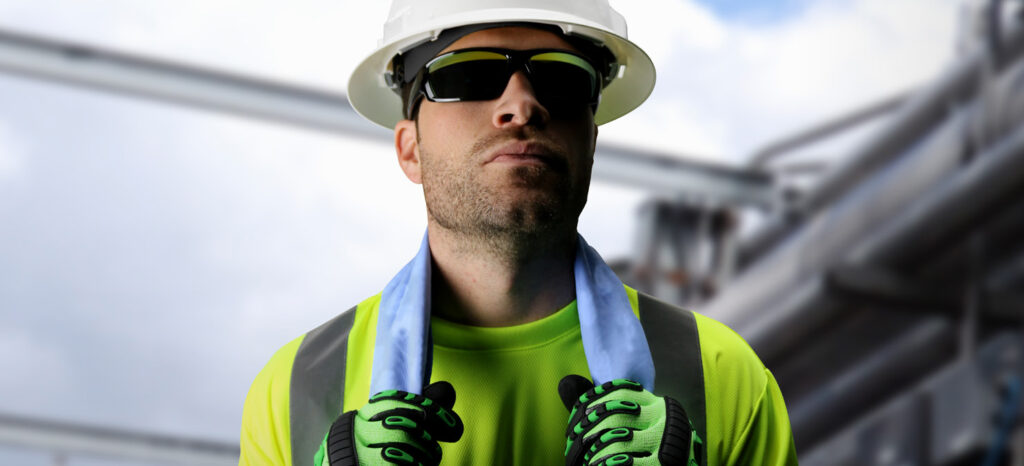
ANSI/ASSP A10.50: Mitigating and Protecting Employees from Heat Stress
A serious condition if not properly managed, heat stress is the heat load to which workers are exposed in a work environment. We generally think of construction, utility, or road workers – people who work outdoors in the middle of summer – as those who need protection from high heat and humidity.
Heat stress, however, affects many workers, including those in the window, door, and insulated glass industry. Production processes within the fenestration industry involve heat: hot-applied sealants, the extrusion process, powder coating, oven presses, tempering ovens, etc.
Add inadequately cooled production environments, lack of education about heat stress – plus workers’ own personal risk factors – and you have conditions that can lead to heat-related illnesses and serious injury.
The body’s reaction to heat stress includes rash, cramps, disorientation, sluggishness, and fainting. Heat stroke – when the body’s core temperature goes above 104°F due to physical exertion in high heat conditions – can cause death.
Even minor dehydration can lead to problems
“Dehydration is more serious than people understand,” says Kerry Schimelfenig, Business Development Manager for Protective Industrial Products (PIP). “The body is comprised of sixty to seventy percent water. For every one percent of fluid lost due to sweating, the heart increases beats by four per minute. Lose two percent and body movement is diminished. Lose three percent and you feel sluggish.”
When dehydrated, the body becomes low in electrolytes, which are essential to body and brain function. Severe dehydration can lead to an emergency room visit where an IV is used to replace lost fluids and salts.
Heat stress is so serious in fact, that from 2018 to 2022, an average of 45 people per year died on-the-job because of it, according to data from the Bureau of Labor Statistics (BLS) Census of Fatal Occupational Injuries (CFOI). Non-fatal heat-related illnesses and injuries for the same period averaged 2,984 per year.
Mitigating heat stress: Create a Heat Stress Management Program
Released in March 2024 by the American Society of Safety Professionals and the American Standards Institute, ANSI/ASSP A10.50 is the first national voluntary consensus standard for protecting construction and demolition workers from heat stress. (Source)
“This standard is applicable to manufacturers of windows and doors,” says Schimelfenig, “because of OSHA’s General Duty Clause.”
An Authorized OSHA Outreach Trainer for Construction & General Industry, Schimelfenig points to Section 5a1 of the OSH Act, which states, “Each employer shall furnish to each of his employees employment and a place of employment which are free from recognized hazards that are causing or are likely to cause death or serious physical harm to his employees.”
The General Duty Clause means “employers must protect employees from serious hazard once they’re aware of it – whether OSHA’s rules specifically address it or not.” (Source)
Schimelfenig says the new Standard establishes requirements to prevent heat illnesses and manage heat stress hazards; it also provides procedures to select and use appropriate engineering and administrative controls to reduce heat-related risks in all work environments.
The first step, according to Schimelgenig, is to create a Heat Stress Management Program. OSHA provides a detailed Heat Stress Guide at its website — https://www.osha.gov/emergency-preparedness/guides/heat-stress.
Performing a workplace assessment
According to the A10.50 Heat Stress Standard, an 80°F temperature can trigger the need for a heat stress program – including humidity or other factors that can make 80°F feel like 90°F or more.
For manufacturers focused on mitigating heat stress for employees inside the physical plant, a heat risk assessment should include the following:
Physical space – Items to consider include seasonal ambient air temperature, direct sunlight from large windows that lack shades, humidity, and air movement from ceiling fans, HVAC system, and open doors or windows that improve ventilation but let in heat as well.
Local heat exposure – Consider space heaters, steam piping, ovens, and high-heat work cells and machinery such as automated welders or cutters, hot melts, sealing, etc. Workers loading trucks with heavy product absorb outdoor heat plus heat rising from hot asphalt.
Physical intensity of work – While automation has reduced processes, plant workers are still active and constantly moving. For example, workers overseeing glass cutting still need to place cut glass on racks, etc. and work up a sweat – as do workers in shipping and receiving.
Company break times – The traditional two breaks plus lunch may not be enough during hot, humid summer months where workers may need to sit and cool off, rest, and rehydrate.
Bulky clothing/PPE – Evaluate all clothing employees wear while on the job. Bulky clothes and PPE that limit sweat evaporation and heat removal should be changed for light-weight, breathable fabrics.
For window and door manufacturers, EVO offers a full line of PPE for reducing heat-stress related issues – including breathable apparel, gloves for summer use, electrolyte powders and frozen popsicles, and cooling towels. Visit Cloud 9 on evoproducts.com or contact your ISC representative for additional details and a product catalog.
Access to drinking water – Consider where drinking water, sports drinks, etc. are stored in the plant – e.g. in the break room only, which is located on one side of the plant – and add drink coolers or small refrigerators in several locations for easy and fast access.
Sums up Schimelfenig, “Heat stress management is similar to any other hierarchy: it starts with determining how your company is dealing with it already. If you’re in the US Southeast, you may have much of this under control and need only a few adjustments.
“As employers, we have an obligation to provide a safe and risk-free work environment,” he adds. “Your employees are your most valuable asset. Train them to understand the importance of managing heat stress – so they don’t overheat and cause an accident or get hurt.”

